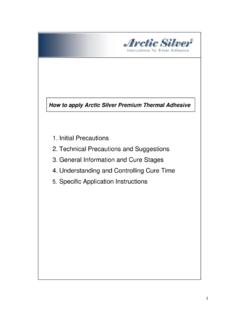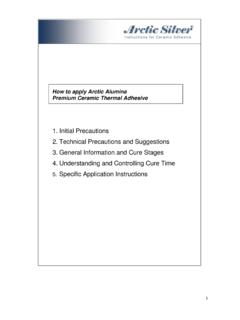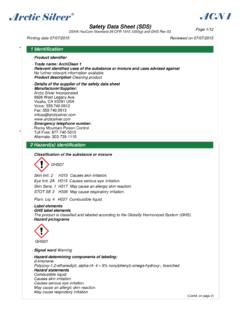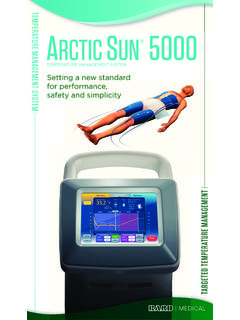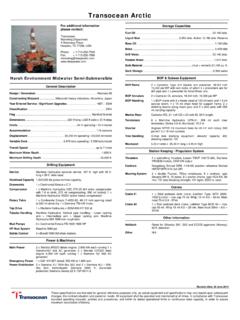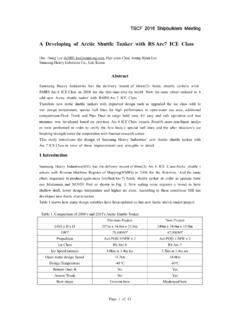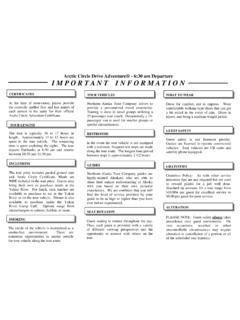Transcription of 1. Initial Precautions 2. Technical ... - Arctic Silver
1 1 How to apply Arctic Alumina Premium Ceramic Thermal Adhesive 1. Initial Precautions 2. Technical Precautions and Suggestions 3. General Information and Cure Stages 4. Understanding and Controlling Cure Time 5. Specific Application instructions 21) Initial Precautions Please read all the instructions before using the adhesive. Don't give it to children or leave it where children can get a hold of it. Don't put it in your mouth. Keep it away from your eyes. Keep it away from pets. Remove from skin with isopropyl alcohol. 2) Technical Precautions and Suggestions Arctic Alumina Thermal Adhesive is permanent adhesive. There is a very good chance that any components you attach with Arctic Alumina Thermal Adhesive will stay attached forever.
2 Arctic Alumina Thermal Adhesive IS NOT considered grease. It dries, sets and glues whatever it is used on. Arctic Alumina Thermal Adhesive IS NOT intended for use on a CPU. Only if your attachment mechanism is broke and you understand it will permanently glue your heatsink to your chip should you attempt doing it. If not then, ONLY use Arctic Silver Thermal Compound/grease on a CPU. Arctic Alumina Thermal Adhesive should be kept cold and away from UV light (sunlight and florescent lighting). We recommend refrigerating the unused material tip down and allowing it to come to room temperature prior to use. 3) General Information and Cure Stages Cure Time Mixing the resin Part A and the curing agent Part B begins a chemical reaction that transforms the combined liquid ingredients to a solid.
3 The time it takes for this transformation is the cure time. As it cures the adhesive passes from the liquid state, through a gel state, before it reaches a solid state. Liquid-Open Stage Liquid-Open time (also "working time") is the portion of the cure time, after mixing, that the resin/curing agent mixture remains a liquid and is workable 3and suitable for application. All assembly and clamping should take place during the open time to assure a dependable bond. Gel- Initial Cure Stage The mixture passes into an Initial cure phase (also called the green stage) when it begins to gel, or "kick-off. The adhesive is no longer workable and will no longer feel tacky.
4 During this stage it progresses from a soft gel consistency to the firmness of hard rubber, you will be able to dent it with your thumbnail. Solid-Final Cure Stage The adhesive mixture has cured to a solid. You should not be able to dent it with your thumbnail. At this point the adhesive has reached about 90% of its ultimate strength, so clamps or other retention aids can be removed. It will continue to cure over the next several hours at room temperature. 4) Understanding and Controlling Cure Time Pot Life Pot life is a term used to compare the usable life of different hardeners. It is the amount of time 100 grams at 72 F remains a liquid. Because pot life is a measure of the cure speed of a specific contained mass (volume) of adhesive rather than a thin film, a hardener's pot life is much shorter than its open time.
5 Curing Temperature The warmer the temperature, the faster the adhesive will cure. The cure temperature is determined by the ambient temperature plus the exothermic heat generated during cure. Ambient temperature is the temperature of the air or material in contact with the adhesive. Air temperature is most often the ambient temperature unless the adhesive is applied to a surface with a different temperature. Generally, the adhesive cures faster when it is warmer. Exothermic heat is produced by the chemical reaction during cure. The amount of heat produced depends on the thickness and surface area of mixed adhesive. In a thicker mass, more heat is retained, causing a faster reaction and more heat.
6 A contained mass of curing adhesive can quickly generate enough heat raise its temperature significantly above the ambient level and increase the curing rate. However, if the same quantity is-spread into a thin layer, exothermic heat is dissipated, and the ambient temperature determines the adhesive s cure time. The thinner the layer of curing adhesive, the less it is affected by exothermic heat, and the slower it cures. Controlling Cure Time 4In warm conditions mix smaller batches that can be used up quickly, or keep the mixture in a thin layer thereby allowing exothermic heat to dissipate and extending open time. The sooner the mixture is transferred or applied (after thorough mixing), the more of the mixture's useful open time will be available for assembly.
7 In cool conditions use supplemental heat to raise the adhesive temperature above the curing agents minimum recommended application temperature. Use a hot air gun, heat lamp or other heat source to warm the resin and curing agent before mixing or after the adhesive is applied. At room temperature, supplemental heat is useful when a quicker cure is desired. Caution! Heating adhesive that has not gelled will lower its viscosity, allowing the adhesive to run or sag more easily on vertical surfaces. Never heat mixed adhesive in a liquid state over 120F(49C). Regardless of what steps are taken to control the cure time, thorough planning of the application and assembly will allow you to make maximum use of the adhesive s open time and cure time.
8 5) Specific Application instructions Step 1 Remove any old adhesive, thermal grease, pads, tape, or other interface materials from the heatsink and chip before attaching the heatsink with the Arctic Alumina Thermal Adhesive. ONLY Arctic Alumina Thermal Adhesive should be between the chip and the heatsink. Step 2 Verify that the heatsink will fit on the chip without interference from any surrounding components. Step 3 Clean the mating surfaces completely with a low residual solvent (isopropyl alcohol will work) and a low lint cloth. (Medical type alcohol pads are excellent.) If the heatsink surface has had thermal compound previously applied, the surface should be thoroughly scrubbed and cleaned with a quality degreaser.
9 Wipe the surface with paper towels before the solvent dries and then follow with the alcohol-cleaning step. It is important to keep the surfaces free of foreign materials and NOT to touch the surfaces. (A hair, piece of lint, and even dead skin cells can affect the thermal interface performance.) Step 4 Arctic Alumina Thermal Adhesive is designed to be mixed 1:1, that is equal amounts of Part A and Part B. Varying the ratio of the mix will not significantly affect the curing time, but may affect the strength of the final bond. DO NOT attempt to alter the cure time by altering the ratio. An accurate ratio is essential for a proper cure and full development of physical properties.
10 Mixed in the proper ratios, Arctic Alumina Thermal Adhesive has a pot life of 3 to 4 minutes at normal room temperatures. Dispense the proper proportions of resin and curing agent onto a clean plastic or metal sheet. Only use as much as you will be able to mix and apply in 5approximately three minutes. Stir the two ingredients together thoroughly with the mixing wand. To assure thorough mixing, scrape the mixing sheet as you mix. If you have adhesive left over after the application, do not dispose of the mixture until the reaction is complete and has cooled. DO NOT mix the two parts of the adhesive on either of the surfaces you will be joining. Always mix the adhesive on a separate clean plastic or metal sheet.

